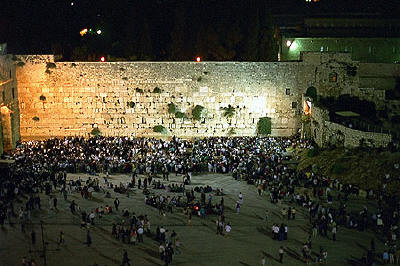Yesterday we trekked to Jerusalem; our destination Yad Vashem & the Kotel on erev Tisha B’Av. The first commemorates the failed attempt to destroy the Jewish people (“never forget”) and the second laments the destruction of the first and second temples in Jerusalem. The first event happening 70 years ago, the latter nearly 2000 years ago. It quite something to spend a day “underground” in the caves of Yad Vashem where is documented the rise of Nazi’s to power, and the near success of the Nazi’s and their allies to purge Europe of Jews, gypsies, homosexuals, Marxists, liberal democrats, and other undesirables. Yad Vashem documents the systematic, organized and “legalistic” approach taken by the Germans with the assistance of allies in the occupied nations.
It quite something to spend a day “underground” in the caves of Yad Vashem where is documented the rise of Nazi’s to power, and the near success of the Nazi’s and their allies to purge Europe of Jews, gypsies, homosexuals, Marxists, liberal democrats, and other undesirables. Yad Vashem documents the systematic, organized and “legalistic” approach taken by the Germans with the assistance of allies in the occupied nations.
The story of the Shoah (as the holocaust is called here) is presented through testimony, live testimony of survivors, writings and sketches of the victims and martyrs. The evidence is overwhelming; the story is heart wrenching. The story begins with a portrayal of the Jewish communities of Europe; painting a vision of a life rich in culture, an everyday life much like the life we live. But you and I know how the story ends. The “testimony” records individuals; individual acts of suffering and of heroism. For it is only on the individual scale that the story can be comprehended by the mind.
 There is the Testimony of the killing pits of the Jews of Vilna and the surroundings in the forest of Ponar in Lithuania (see film) told by a survivor of the massacre, who found himself and another teenage boy miraculously alive under a mountain of bodies of his fellow Jews. In perspective, this was but a single testimony and yet the vision of a young teenage boy pulling himself alive out of a pit of corpses (family, friends and compatriots, the entire community) and escaping ultimately to Israel, moved me.
There is the Testimony of the killing pits of the Jews of Vilna and the surroundings in the forest of Ponar in Lithuania (see film) told by a survivor of the massacre, who found himself and another teenage boy miraculously alive under a mountain of bodies of his fellow Jews. In perspective, this was but a single testimony and yet the vision of a young teenage boy pulling himself alive out of a pit of corpses (family, friends and compatriots, the entire community) and escaping ultimately to Israel, moved me.
Years ago on my last visit I was moved by the Yad Vashem children’s memorial. Six candles and a room of mirrors. Six candles representing the six days of creation. Six candles representing the spark of life; the seed from which the heavens are created. Six candles reflected endlessly in a room of mirrors representing the one and half million children who died in the Shoah and the tens of millions and billions of stars in the heaven that would have been their progeny. Louis XIV build his great hall of mirrors at Versailles. Yad Vashem’s children’s memorial with its hall of mirrors captures the infinity and the potential of life.
I seem to have forgotten about Tisha b’Av. After Yad Vashem we met the daughter of a good friend from New York who had made aliyah to Jerusalem. The restaurants were closing early for the “fast” of Tisha b’Av where Jews remember the destruction of the first and second temples in Jerusalem. For some, this is the “rock concert” at the Kotel, the time when religious Jews pour forth from Mea Sharim and other parts and converge on the last remains of the great temple built by Solomon, the “Western Wall”, Kotel in Hebrew. Here was a blending of Jewish peoples from all over the world, each with their own customs, singing, chanting, lamenting and praying on the site of the great templates. Many chanted from the Book of Psalms in remembrance. Psalm 137 (click here) and Psalm 48 (click here) give you a sense of the prayers offered.
We had walked nearly 30 minutes up hill from our parking spot in the German colony. We entered the Jaffa Gate and proceeded through the Armenian quarter into the Jewish quarter. We were surrounded by the press of humanity; at times you could barely breath from the press. And yes, we did read from the Psalms at the Kotel. But between Yad Vashem and the Kotel, I was more moved by the former. The first celebrates the survival of a vibrant people. The later laments that passing of a “temple”, a building built by a king where a priestly class ruled. I can appreciate the holiness of the site and the lamentations around us. But I was more uplift by the loss of the “people” and the potential for the future represented at Yad Vashem.
